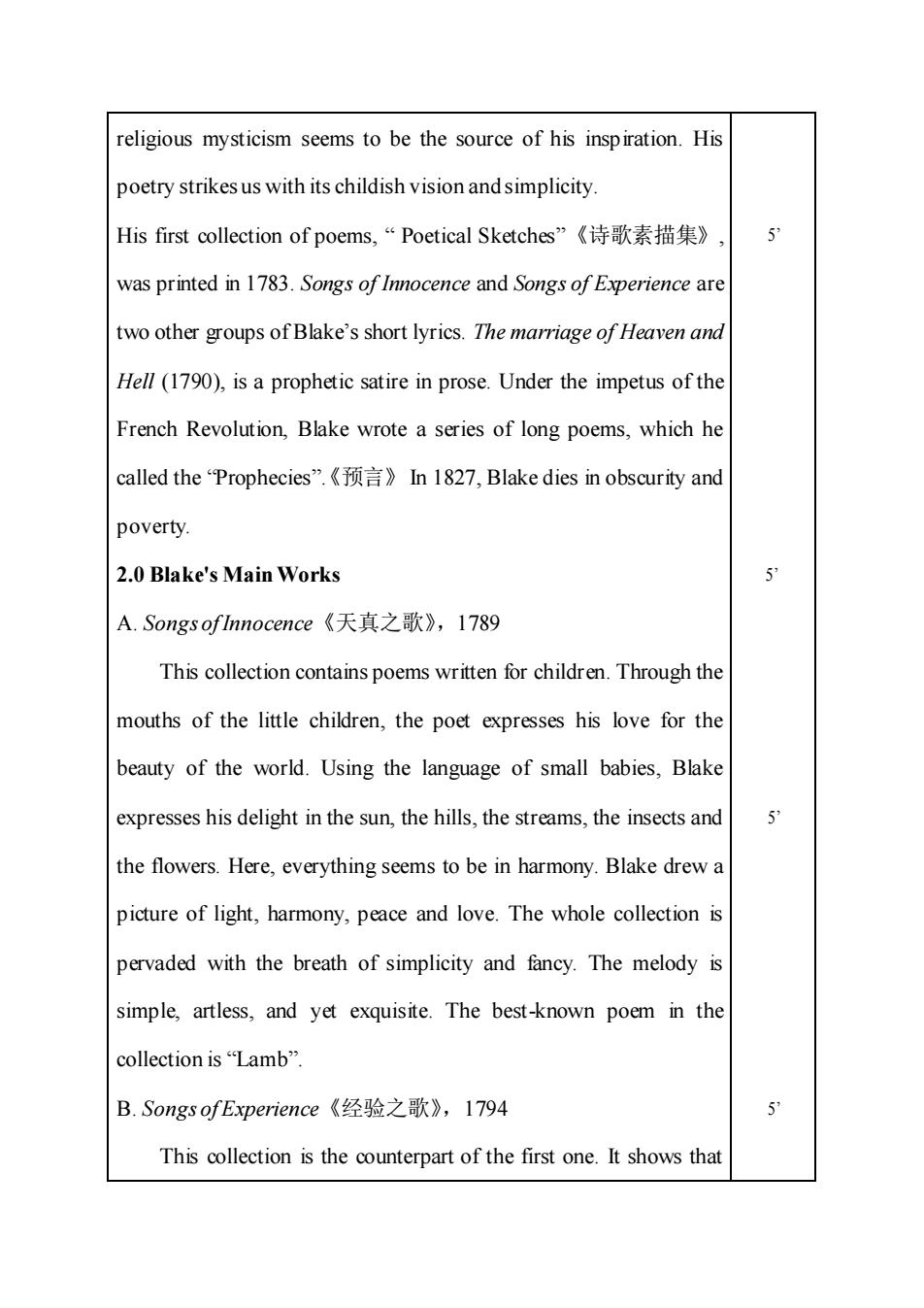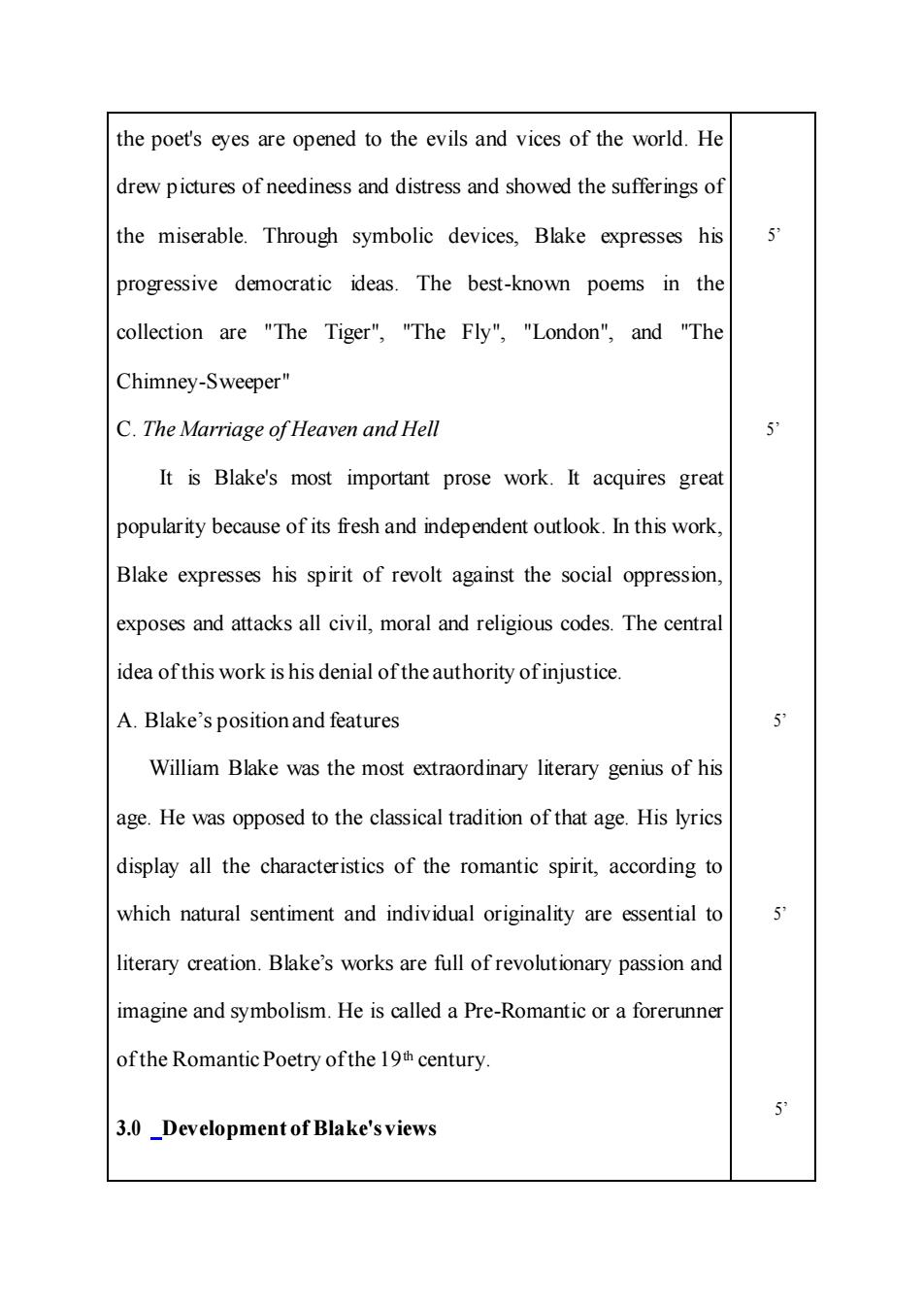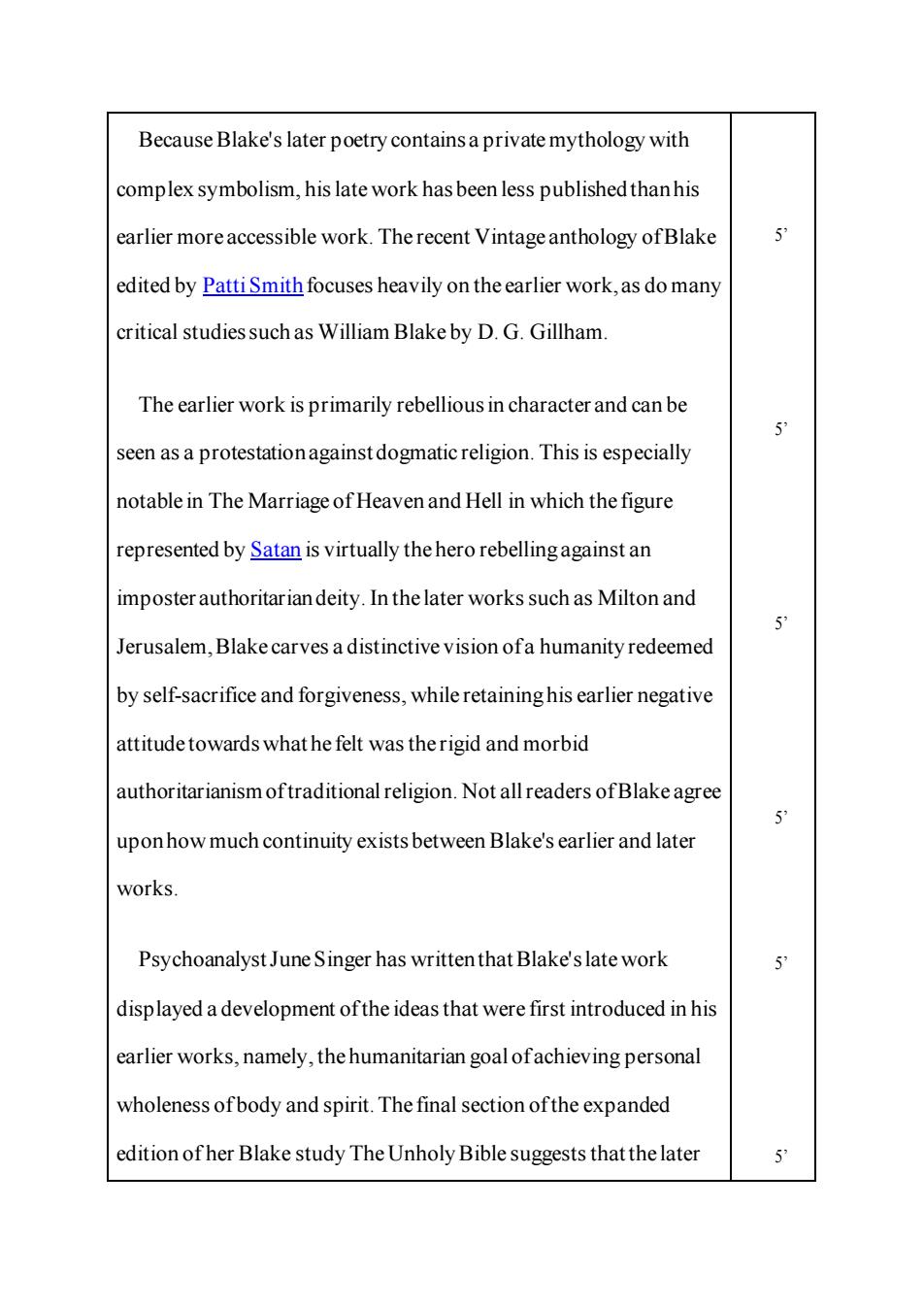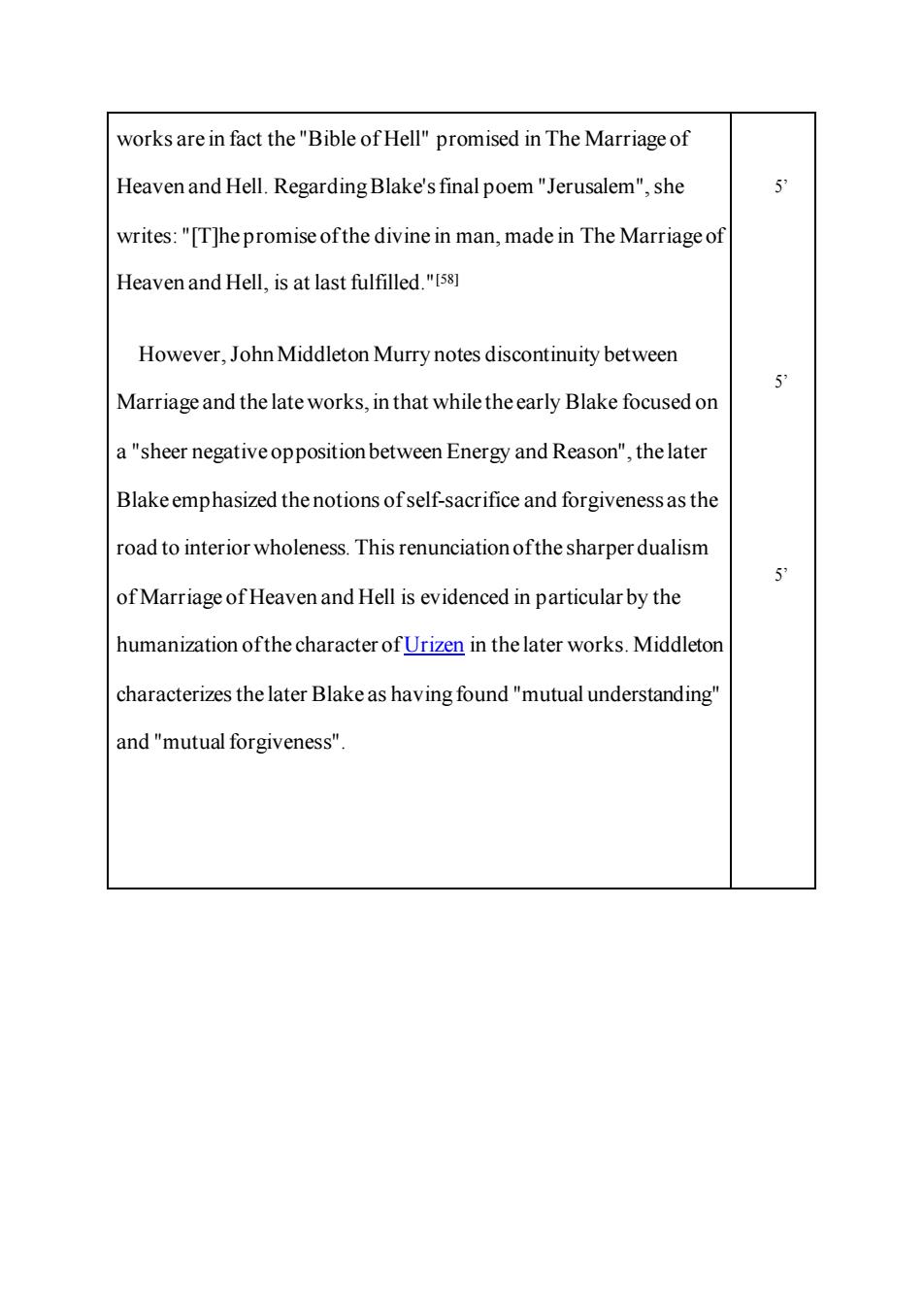
教 案 课程名称 英因文学 授课专业及层次 授课内容 Lecture seventeen: Introduction to William Blake 学时数 2 To let the students see the significance of literature; 教学目的 TolethestudcntshavethegenealimpresionofBritishlterature To let the students get basic knowledge of British literature 重点 To get to know the general clue of British literary history To get to know the important British writers and literary works 难点 To get to know some key terms 自学内容 Additional reading materials about the western cultural background 使用教具 Projector,audio-video machine 相关学科知识 Western culture and general Literary theories Open questions and answers in class 教学法Class discussion and analysis 讲授内容纲要、要求及时间分配 William Blake(1757-1827) 1.0Life Blake was the son of a London tradesman.He never went to school but learned to read and write at home.His favorite writers were Shakespeare,Miltonand Chatterton(查特顿). When he was fourteen,he was apprenticed to an engraver,but his business never became prosperous.Blake was a lover of poetry He devoted some of his time to writing verses.In 1782,he married an illiterate girl,who helped him a lot. Blake is famous for his short lyrics.They are remarkable and 5 highly individual.He looks toward an anarchistic society and a
教 案 课程名称 英国文学 授课专业及层次 授课内容 Lecture seventeen: Introduction to William Blake 学时数 2 教学目的 To let the students see the significance of literature; To let the students have the general impression of British literature. To let the students get basic knowledge of British literature 重 点 To get to know the general clue of British literary history To get to know the important British writers and literary works 难 点 To get to know some key terms To know some methods for literary appreciation and criticism 自学内容 Additional reading materials about the western cultural background 使用教具 Projector, audio-video machine 相关学科知识 Western culture and general Literary theories 教 学 法 Open questions and answers in class Class discussion and analysis 讲授内容纲要、要求及时间分配 William Blake (1757-1827) 1.0 Life Blake was the son of a London tradesman. He never went to school but learned to read and write at home. His favorite writers were Shakespeare, Milton and Chatterton(查特顿). When he was fourteen, he was apprenticed to an engraver, but his business never became prosperous. Blake was a lover of poetry. He devoted some of his time to writing verses. In 1782, he married an illiterate girl, who helped him a lot. Blake is famous for his short lyrics. They are remarkable and highly individual. He looks toward an anarchistic society and a 5’ 5’

religious mysticism seems to be the source of his inspiration.His poetry strikes us with its childish vision and simplicity. His first collection of poems,“Poetical Sketches”《诗歌素描集》, 5 was printed in 1783.Songs of Innocence and Songs of Experience are two other groups of Blake's short lyrics.The marriage of Heaven and Hell(1790),is a prophetic satire in prose.Under the impetus of the French Revolution,Blake wrote a series of long poems,which he called theProphecies'”.《预言》nl827,Blake dies in obscurity and poverty. 2.0 Blake's Main Works 5 A.Songs of Innocence《天真之歌》,1789 This collection contains poems written for children.Through the mouths of the little children,the poet expresses his love for the beauty of the world.Using the language of small babies,Blake expresses his delight in the sun,the hills,the streams,the insects and 5 the flowers.Here,everything seems to be in harmony.Blake drew a picture of light,harmony,peace and love.The whole collection is pervaded with the breath of simplicity and fancy.The melody is simple,artless,and yet exquisite.The best-known poem in the collection is"Lamb” B.Songs ofExperience《经验之歌》,1794 5 This collection is the counterpart of the first one.It shows that
religious mysticism seems to be the source of his inspiration. His poetry strikes us with its childish vision and simplicity. His first collection of poems, “ Poetical Sketches”《诗歌素描集》, was printed in 1783. Songs of Innocence and Songs of Experience are two other groups of Blake’s short lyrics. The marriage of Heaven and Hell (1790), is a prophetic satire in prose. Under the impetus of the French Revolution, Blake wrote a series of long poems, which he called the “Prophecies”.《预言》In 1827, Blake dies in obscurity and poverty. 2.0 Blake's Main Works A. Songs of Innocence《天真之歌》,1789 This collection contains poems written for children. Through the mouths of the little children, the poet expresses his love for the beauty of the world. Using the language of small babies, Blake expresses his delight in the sun, the hills, the streams, the insects and the flowers. Here, everything seems to be in harmony. Blake drew a picture of light, harmony, peace and love. The whole collection is pervaded with the breath of simplicity and fancy. The melody is simple, artless, and yet exquisite. The best-known poem in the collection is “Lamb”. B. Songs of Experience《经验之歌》,1794 This collection is the counterpart of the first one. It shows that 5’ 5’ 5’ 5’

the poet's eyes are opened to the evils and vices of the world.He drew pictures of neediness and distress and showed the sufferings of the miserable.Through symbolic devices,Blake expresses his 5 progressive democratic ideas.The best-known poems in the collection are "The Tiger","The Fly","London",and "The Chimney-Sweeper" C.The Marriage of Heaven and Hell 5 It is Blake's most important prose work.It acquires great popularity because of its fresh and independent outlook.In this work Blake expresses his spirit of revolt against the social oppression exposes and attacks all civil,moral and religious codes.The central idea of this work is his denial ofthe authority ofinjustice A.Blake's positionand features William Blake was the most extraordinary literary genius of his age.He was opposed to the classical tradition of that age.His lyrics display all the characteristics of the romantic spirit,according to which natural sentiment and individual originality are essential to literary creation.Blake's works are full of revolutionary passion and imagine and symbolism.He is called a Pre-Romantic or a forerunner ofthe Romantic Poetry ofthe 19th century. 5 3.0_Development of Blake's views
the poet's eyes are opened to the evils and vices of the world. He drew pictures of neediness and distress and showed the sufferings of the miserable. Through symbolic devices, Blake expresses his progressive democratic ideas. The best-known poems in the collection are "The Tiger", "The Fly", "London", and "The Chimney-Sweeper" C. The Marriage of Heaven and Hell It is Blake's most important prose work. It acquires great popularity because of its fresh and independent outlook. In this work, Blake expresses his spirit of revolt against the social oppression, exposes and attacks all civil, moral and religious codes. The central idea of this work is his denial of the authority of injustice. A. Blake’s position and features William Blake was the most extraordinary literary genius of his age. He was opposed to the classical tradition of that age. His lyrics display all the characteristics of the romantic spirit, according to which natural sentiment and individual originality are essential to literary creation. Blake’s works are full of revolutionary passion and imagine and symbolism. He is called a Pre-Romantic or a forerunner of the Romantic Poetry of the 19th century. 3.0 Development of Blake's views 5’ 5’ 5’ 5’ 5’

Because Blake's later poetry containsa private mythology with complex symbolism,his late work has been less published thanhis earlier more accessible work.The recent Vintage anthology of Blake 5 edited by Patti Smith focuses heavily on the earlier work,as do many critical studies such as William Blake by D.G.Gillham. The earlier work is primarily rebellious in character and can be 5 seen as a protestation against dogmatic religion.This is especially notable in The Marriage of Heaven and Hell in which the figure represented by Satan is virtually the hero rebellingagainst an imposter authoritarian deity.In the later works such as Milton and 5 Jerusalem,Blake carves a distinctive vision ofa humanity redeemed by self-sacrifice and forgiveness,while retaininghis earlier negative attitude towards what he felt was the rigid and morbid authoritarianism oftraditional religion.Not all readers ofBlake agree 5 uponhow much continuity exists between Blake's earlier and later works. Psychoanalyst June Singer has writtenthat Blake'slate work 5 displayed a development ofthe ideas that were first introduced in his earlier works,namely,the humanitarian goal ofachieving personal wholeness ofbody and spirit.The final section ofthe expanded edition ofher Blake study The Unholy Bible suggests that the later
Because Blake's later poetry contains a private mythology with complex symbolism, his late work has been less published than his earlier more accessible work. The recent Vintage anthology of Blake edited by Patti Smith focuses heavily on the earlier work, as do many critical studies such as William Blake by D. G. Gillham. The earlier work is primarily rebellious in character and can be seen as a protestation against dogmatic religion. This is especially notable in The Marriage of Heaven and Hell in which the figure represented by Satan is virtually the hero rebelling against an imposter authoritarian deity. In the later works such as Milton and Jerusalem, Blake carves a distinctive vision of a humanity redeemed by self-sacrifice and forgiveness, while retaining his earlier negative attitude towards what he felt was the rigid and morbid authoritarianism of traditional religion. Not all readers of Blake agree upon how much continuity exists between Blake's earlier and later works. Psychoanalyst June Singer has written that Blake's late work displayed a development of the ideas that were first introduced in his earlier works, namely, the humanitarian goal of achieving personal wholeness of body and spirit. The final section of the expanded edition of her Blake study The Unholy Bible suggests that the later 5’ 5’ 5’ 5’ 5’ 5’

works are in fact the"Bible of Hell"promised in The Marriage of Heaven and Hell.Regarding Blake's final poem"Jerusalem",she 5 writes:"[T]hepromise ofthe divine in man,made in The Marriage of Heaven and Hell,is at last fulfilled."5 However,John Middleton Murry notes discontinuity between 5 Marriage and the late works,in that while the early Blake focused on a"sheer negativeopposition between Energy and Reason",the later Blake emphasized the notions of self-sacrifice and forgiveness as the oad to interior wholeness.This renunciation ofthe sharper dualism 5 of Marriage of Heaven and Hell is evidenced in particular by the humanization ofthe character ofUrizen in the later works.Middleton characterizes the later Blake as having found"mutual understanding and"mutual forgiveness
works are in fact the "Bible of Hell" promised in The Marriage of Heaven and Hell. Regarding Blake's final poem "Jerusalem", she writes: "[T]he promise of the divine in man, made in The Marriage of Heaven and Hell, is at last fulfilled."[58] However, John Middleton Murry notes discontinuity between Marriage and the late works, in that while the early Blake focused on a "sheer negative opposition between Energy and Reason", the later Blake emphasized the notions ofself-sacrifice and forgiveness as the road to interior wholeness. This renunciation of the sharper dualism of Marriage of Heaven and Hell is evidenced in particular by the humanization of the character of Urizen in the later works. Middleton characterizes the later Blake as having found "mutual understanding" and "mutual forgiveness". 5’ 5’ 5’